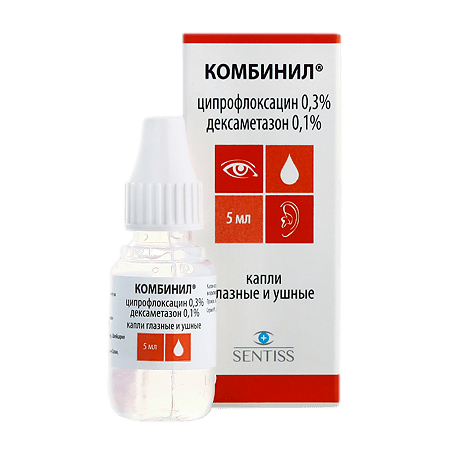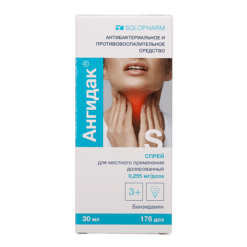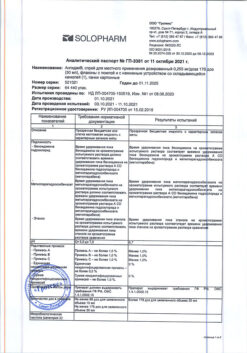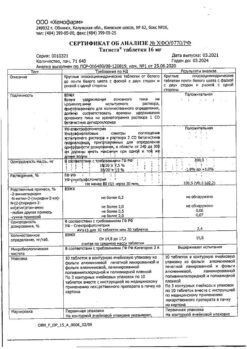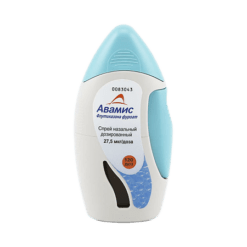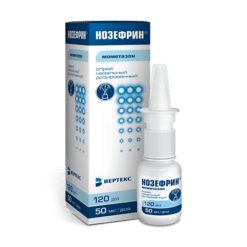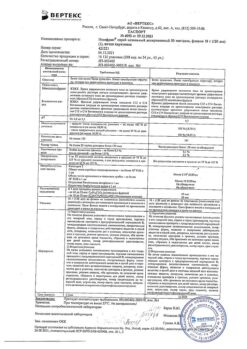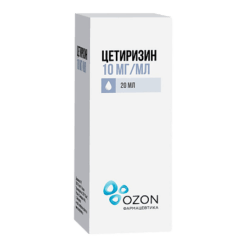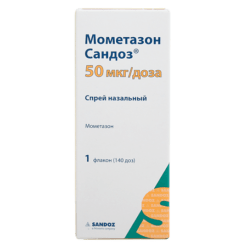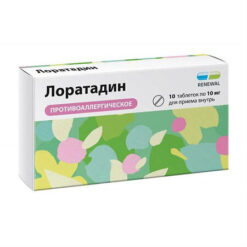No products in the cart.
Combinil, eye and ear drops 5 ml
€15.27 €13.24
Description
A drug with antibacterial and anti-inflammatory action for local application in ophthalmology and ENT practice. The therapeutic effect of Combinil is due to the antibacterial action of ciprofloxacin and anti-inflammatory action of dexamethasone.
Ciprofloxacin is an antibacterial drug from the group of fluoroquinolones, has a broad spectrum of action and has a bactericidal effect. The drug inhibits bacterial enzyme DNA-gyrase, as a consequence of which DNA replication and synthesis of bacterial cell proteins are disrupted. Ciprofloxacin acts both on multiplying microorganisms and on those which are in the dormant stage.
It is active against Gram-negative microorganisms: Esherichia coli, Salmonella spp., Shigella spp., Proteus spp. (indole-positive and indole-negative), Morganella morganii, Citrobacter spp., Klebsiella spp., Enterobacter spp., Vibrio spp., Campylobacter spp., Hafnia spp, Providencia stuartii, Haemophilus influenzae, Pasteurella multocida, Pseudomonas spp., Gardnerella spp., Legionella pneumophila, Neisseria spp., Moraxella catarrhalis, Acinetobacter spp, Chlamydia spp.; Gram-positive microorganisms: Staphylococcus spp., Streptococcus pyogenes, Streptococcus agalactiae, Cynebacterium diphtheriae, Listeria monocytogenes.
Dexamethasone is a synthetic GCS. When applied topically, the therapeutic activity of dexamethasone is due to its anti-inflammatory, anti-allergic and antiproliferative effects. It reduces capillary permeability and proliferation, local exudation, cell infiltration, phagocytic activity, collagen deposition and fibroblast activity, inhibits scar tissue formation. Thus, dexamethasone reduces the main symptoms of inflammation.
Pharmacokinetics
When used in ophthalmology, ciprofloxacin penetrates well into various tissues of the eye except for the lens. Cmax occurs within 30 minutes, the highest concentration is observed in the moisture of the anterior chamber. Systemic reabsorption is observed.
However, the drug concentration reached in the blood is well below the detection limit and is not clinically relevant. Dexamethasone penetrates well into the corneal epithelium and conjunctiva after injection into the conjunctival sac; therapeutic concentrations are reached in the aqueous humor of the eye; the rate of penetration increases with inflammation or mucosal damage.
When used in otorhinolaryngologic practice when a fixed combination of ciprofloxacin and dexamethasone is administered into the ear canal, the Cmax for ciprofloxacin is 1.55 ng/L and for dexamethasone 0.86 ng/L. The T1/2 of ciprofloxacin is 2.9 h and that of dexamethasone is 2.8 h.
The excipient hydroxypropyl betacyclodextrin promotes prolonged storage of the active substance on the anterior surface of the eye, thus increasing the effectiveness and duration of action of the drug.
Indications
Indications
Infectious and inflammatory diseases of the eye and its appendages:
acute and subacute conjunctivitis;
keratitis;
anterior uveitis;
blepharitis and other inflammatory diseases of the eyelids;
prevention and treatment of infectious complications after injuries to the eye and its appendages and during operations on the eyeball.
Infectious and inflammatory diseases of the ear:
acute external otitis media;
acute otitis media with eardrum shunt;
acute otitis media with granulations and otorrhea in the presence of an eardrum shunt.
Pharmacological effect
Pharmacological effect
A drug with antibacterial and anti-inflammatory effects for topical use in ophthalmology and ENT practice. The therapeutic effect of the drug Combinil is due to the antibacterial effect of ciprofloxacin and the anti-inflammatory effect of dexamethasone.
Ciprofloxacin is an antibacterial drug from the group of fluoroquinolones, has a wide spectrum of action and has a bactericidal effect. The drug inhibits the enzyme DNA gyrase of bacteria, as a result of which DNA replication and the synthesis of bacterial cellular proteins are disrupted. Ciprofloxacin acts both on microorganisms that are reproducing and those in the dormant stage.
Active against gram-negative microorganisms: Esherichia coli, Salmonella spp., Shigella spp., Proteus spp. (indole-positive and indole-negative), Morganella morganii, Citrobacter spp., Klebsiella spp., Enterobacter spp., Vibrio spp., Campylobacter spp., Hafnia spp., Providencia stuartii, Haemophilus influenzae, Pasteurella multocida, Pseudomonas spp., Gardnerella spp., Legionella pneumophila, Neisseria spp., Moraxella catarrhalis, Acinetobacter spp., Brucella spp., Chlamydia spp.; gram-positive microorganisms: Staphylococcus spp., Streptococcus pyogenes, Streptococcus agalactiae, Corynebacterium diphtheriae, Listeria monocytogenes.
Dexamethasone is a synthetic corticosteroid. When applied topically, the therapeutic activity of dexamethasone is due to its anti-inflammatory, antiallergic and antiproliferative effects. It reduces capillary permeability and proliferation, local exudation, cellular infiltration, phagocytic activity, collagen deposition and fibroblast activity, and inhibits the formation of scar tissue. Thus, dexamethasone reduces the main symptoms of inflammation.
Pharmacokinetics
When used in ophthalmology, ciprofloxacin penetrates well into various tissues of the eye, with the exception of the lens. Cmax occurs within 30 minutes, the highest concentration is observed in the moisture of the anterior chamber. Systemic reabsorption is observed.
However, the drug concentration achieved in the blood is well below the detection limit and has no clinical significance. Dexamethasone, after instillation into the conjunctival sac, penetrates well into the corneal epithelium and conjunctiva; at the same time, therapeutic concentrations are achieved in the aqueous humor of the eye; with inflammation or damage to the mucous membrane, the penetration rate increases.
When used in otorhinolaryngological practice when a fixed combination of ciprofloxacin and dexamethasone is administered into the ear canal, Cmax for ciprofloxacin is 1.55 ng/l, and for dexamethasone 0.86 ng/l. T1/2 of ciprofloxacin – 2.9 hours, dexamethasone – 2.8 hours.
Hydroxypropylbetacyclodextrin, which is part of the drug as an auxiliary component, promotes long-term preservation of the active substance on the front surface of the eye, thereby increasing the effectiveness and duration of action of the drug.
Special instructions
Special instructions
For bacterial inflammatory diseases of the ear
Before using ear drops, you should sanitize the external auditory canal (rinse and dry the external auditory canal).
Before instilling the drug into the external auditory canal, you should warm it to body temperature by holding it in your hands for 1-2 minutes.
It is necessary to lie on your side or tilt your head back to facilitate instillation. Place the indicated number of drops into the external auditory canal. Allow the drops to drain into the external auditory canal, pulling the earlobe down and back. Keep your head tilted back for about 2 minutes. You can place a cotton wool pad in the external auditory canal.
For bacterial inflammatory diseases of the eye and its appendages
Long-term use can lead to increased intraocular pressure with subsequent damage to the optic nerve, decreased visual acuity and fields, and the formation of posterior subcapsular cataracts.
When using the drug Combinil-Duo for more than 10 days, it is necessary to monitor intraocular pressure.
For acute purulent eye infections, corticosteroids may worsen or mask symptoms.
Long-term use of the drug may reduce the immune response and lead to the development of secondary eye infections.
Patients using contact lenses should remove them before instillation of the drug and put them back on only after 20 minutes, since the preservative contained in the drug may have an adverse effect on the eye tissue.
The bottle must be closed after each use.
Do not touch the tip of the pipette to your eye.
Impact on the ability to drive vehicles and machinery
After using the drug, a decrease in the clarity of visual perception is possible; therefore, immediately after instillation, it is not recommended to drive a car or engage in activities that require increased attention and speed of psychomotor reactions.
Active ingredient
Active ingredient
Dexamethasone, Ciprofloxacin
Composition
Composition
Active ingredients:
dexamethasone 1 mg,
ciprofloxacin (in the form of hydrochloride) 3 mg;
Excipients:
benzalkonium chloride,
hydroxypropyl betadex,
disodium edetate,
mannitol,
hydrochloric acid (up to pH 4.0),
water d/i.
Pregnancy
Pregnancy
Combinil is not recommended for children under 18 years of age, pregnant women or during lactation.
Contraindications
Contraindications
herpetic keratitis and other viral lesions of the cornea and conjunctiva;
eye tuberculosis;
fungal infections of the eyes;
viral infections of the ear canal;
perforation of the eardrum;
children under 18 years of age;
pregnancy;
lactation period (breastfeeding);
hypersensitivity to the active substances or to any of the auxiliary ingredients of the drug.
Side Effects
Side Effects
From the organ of vision: horn-shaped infiltrates, burning, redness, itching of the eyes, conjunctivitis, keratitis, periocular edema, feeling of a foreign body in the eye, photophobia, blurred vision, dry eye, swelling of the eyelids, conjunctival hyperemia, glaucoma and damage to the optic nerve, decreased visual acuity and narrowing of visual fields, cataract formation, secondary infection (fungal and bacterial), thinning of the cornea and/or perforation of the eyeball.
On the part of the hearing organ: discomfort and pain in the ear, itching in the ear, ear congestion.
Other: facial swelling, delayed wound healing, taste perversions, skin rash.
Interaction
Interaction
Systemic absorption when applied topically is negligible, so the likelihood of drug interactions is extremely low.
Inducers, inhibitors and substrates of liver enzymes. Drugs that inhibit the activity of cytochrome P4503A4 (CYP3A4) (barbiturates, phenytoin, carbamazepine, rifampicin) can increase the metabolism of corticosteroids. Drugs that induce CYP3A4 activity (ketoconazole, macrolides) may potentially cause an increase in plasma corticosteroid levels.
Dexamethasone is a moderate CYP3A4 inducer. Co-administration with drugs metabolized by CYP3A4 (erythromycin) may increase their clearance, reducing plasma concentrations.
When ciprofloxacin is combined with other antimicrobial drugs (beta-lactam antibiotics, aminoglycosides, clindamycin, metronidazole), synergism is usually observed; can be successfully used in combination with azlocillin and ceftazidime for infections caused by Pseudomonas spp.; with mezlocillin and other beta-lactam antibiotics – for streptococcal infections; with isoxazolylpenicillins and vancomycin – for staphylococcal infections; with metronidazole and clindamycin – for anaerobic infections.
Can be successfully used in combination with azlocillin and ceftazidime for infections caused by Pseudomonas spp.
With mezlocillin and other beta-lactam antibiotics – for streptococcal infections.
With isoxazolylpenicillins and vancomycin – for staphylococcal infections.
With metronidazole and clindamycin – for anaerobic infections.
Overdose
Overdose
Symptoms: local – the occurrence of punctate keratitis, erythema, increased lacrimation, swelling and itching of the eyelids. There are no data on systemic manifestations of overdose.
Treatment: there is no specific antidote. You should rinse your eyes with water, discontinue the drug and prescribe symptomatic therapy.
Storage conditions
Storage conditions
In a place protected from light, at a temperature not exceeding 25 °C (do not freeze)
Shelf life
Shelf life
2 years
Manufacturer
Manufacturer
Sentiss Pharma Pvt.Ltd, India
Additional information
| Shelf life | 2 years |
|---|---|
| Conditions of storage | In the dark place at a temperature not exceeding 25 °C (do not freeze) |
| Manufacturer | Sentiss Pharma Pvt.Ltd, India |
| Medication form | eye and ear drops |
| Brand | Sentiss Pharma Pvt.Ltd |
Related products
Buy Combinil, eye and ear drops 5 ml with delivery to USA, UK, Europe and over 120 other countries.

